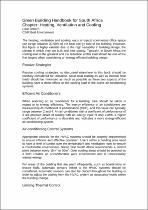JavaScript is disabled for your browser. Some features of this site may not work without it.
- ResearchSpace
- →
- Research Publications/Outputs
- →
- Book Chapters
- →
- View Item
| dc.contributor.author |
Osburn, L

|
|
| dc.date.accessioned | 2009-04-14T12:52:58Z | |
| dc.date.available | 2009-04-14T12:52:58Z | |
| dc.date.issued | 2009-02 | |
| dc.identifier.citation | Osburn, L. 2009. Heating, ventilation and cooling. Green building handbook South Africa. Vol.1 (A guide to ecological design). pp 161-168 | en |
| dc.identifier.isbn | 9780620427241 | |
| dc.identifier.uri | http://hdl.handle.net/10204/3311 | |
| dc.description | Copyright: 2009 Green Building | en |
| dc.description.abstract | The heating, ventilation and cooling loads of typical commercial office space can range between 30-50% of the total energy load of the building. However, this figure is highly variable due to the high variability in building design, the climate in which they are built and their quality. Typically, in South Africa the cooling load is the greatest and the reduction of this load should be one of the first targets when considering an energy-efficient building design. This chapter provides an overview on temperature control systems that can be implemented in buildings | en |
| dc.language.iso | en | en |
| dc.publisher | Green Building | en |
| dc.subject | Heating | en |
| dc.subject | Cooling | en |
| dc.subject | Ventilation | en |
| dc.subject | Air conditioners | en |
| dc.subject | Temperature | en |
| dc.subject | Green building handbook South Africa | en |
| dc.subject | Ecological design | en |
| dc.title | Heating, ventilation and cooling | en |
| dc.type | Book Chapter | en |
| dc.identifier.apacitation | Osburn, L. (2009). Heating, ventilation and cooling., <i></i> Green Building. http://hdl.handle.net/10204/3311 | en_ZA |
| dc.identifier.chicagocitation | Osburn, L. "Heating, ventilation and cooling" In <i></i>, n.p.: Green Building. 2009. http://hdl.handle.net/10204/3311. | en_ZA |
| dc.identifier.vancouvercitation | Osburn L. Heating, ventilation and cooling. [place unknown]: Green Building; 2009. [cited yyyy month dd]. http://hdl.handle.net/10204/3311. | en_ZA |
| dc.identifier.ris | TY - Book Chapter AU - Osburn, L AB - The heating, ventilation and cooling loads of typical commercial office space can range between 30-50% of the total energy load of the building. However, this figure is highly variable due to the high variability in building design, the climate in which they are built and their quality. Typically, in South Africa the cooling load is the greatest and the reduction of this load should be one of the first targets when considering an energy-efficient building design. This chapter provides an overview on temperature control systems that can be implemented in buildings DA - 2009-02 DB - ResearchSpace DP - CSIR KW - Heating KW - Cooling KW - Ventilation KW - Air conditioners KW - Temperature KW - Green building handbook South Africa KW - Ecological design LK - https://researchspace.csir.co.za PY - 2009 SM - 9780620427241 T1 - Heating, ventilation and cooling TI - Heating, ventilation and cooling UR - http://hdl.handle.net/10204/3311 ER - | en_ZA |






